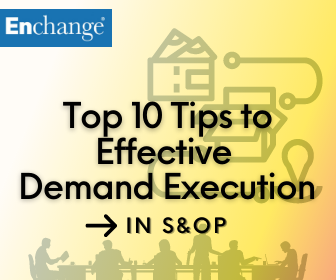The Enchange Supply Chain House; the one-stop shop for the elements you need to achieve supply chain excellence.
In successful FMCG companies, Sales & Operational Planning (S&OP) is the flexible glue that holds your processes together, ensuring demand and supply are balanced along the chain and most importantly, sees everyone operate to the same set of unambiguous sales, volume and financial numbers.
In this series of articles we have provided Top 10 Tips for each of the key stages of S&OP.
- Demand Review - have you captured unconstrained demand?
- Supply Review - what is available and what is not?
- Financial Evaluation - how do these plans convert to cash?
- Consensus - is everybody on board with the plan?
This article looks at the further detail of how you execute your S&OP plans. You may have the most reliable and accurate demand signal but this is wasted if execution activities are vague and ill defined.

Top 10 Tips – S&OP Demand Execution
- Customer Service, Distribution Management & DRP Policies. Is there a clearly written Customer Services & Distribution Management policy including sales order processing, available-to-promise, inventory management rules, shortage prioritisation guidelines and service levels? Is there a clear and concise Distribution Replenishment Planning (DRP) policy that covers purpose, process and participants? Is ownership of the policies clear and routine reviews are carried out?
- Customer Service, Distribution Management & DRP Process & Procedures. Have these been developed by the operational team and not top-down diktats? Are these processes and procedures clearly documented and entirely focussed on delivering the highest possible levels of customer service?
- Customer Orders. Are orders captured on a timely basis and any customer orders awaiting processing are monitored/measured and managed? Are sales order processing, available-to-promise, contract sales, sales order analysis all hosted on an ERP System and are fully utilised in the preparation of sales reports? Do mechanisms exist for matching orders to forecast and for handling abnormal and unexpected demand? Are all orders given a clear promise date at order entry and service levels are given the highest possible priority?
- Order Promising. You have an order promising process? Does the order promising function have access to appropriate and timely information, such as Available to Promise (ATP), to ensure that reliable promises can be made?
- Order Errors & Changes. Are errors in customer order entry monitored and reviewed with plans made to reduce/eliminate errors by increasing input quality? Are the number of customer initiated sales change orders monitored and managed down to an acceptable level by sales colleagues?
- Customer Order Entry Integration. Are customer order entry and promising processes reliably integrated with production plan, factory scheduling and inventory data?
- DRP Information. Is DRP information used for S&OP, master production scheduling, supplier scheduling, transportation planning and shipment scheduling? Are distribution requirements considered and reconciled through the S&OP and master production scheduling processes?
- DRP System. Is the complete distribution network maintained within the DRP system and reflects which SKUs are stocked at each distribution location? Does the DRP system include firm planned orders, pegging (demand/supply) capabilities, promised customer orders, back-orders, supplier scheduling and shipment schedules?
- Transportation Planning & Costs. Do the DRP process and system provide the required information for transportation planning to respond to the stock needs of distribution locations and to optimise transportation costs?
- Distribution Resource Planning. Is Distribution Resource Planning run weekly or more frequently as required, to meet the needs of the business?
Capture and understanding of the demand is vital but there are many activities required in order to translate demand information into successful market execution. Getting this wrong will impact across the supply chain as stocks may be too low/high and customer service low and variable. These risks can be minimised to levels acceptable to clients and producers by following these Top 10 Tips.
Read more articles on Supply Chain Excellence and Route To Market on our website where you can also subscribe to our frequent updates.
Finally, feel free to use any of our contact routes including Live Chat, if you have any questions about how the Enchange Supply Chain House can assist your journey to supply chain excellence.







